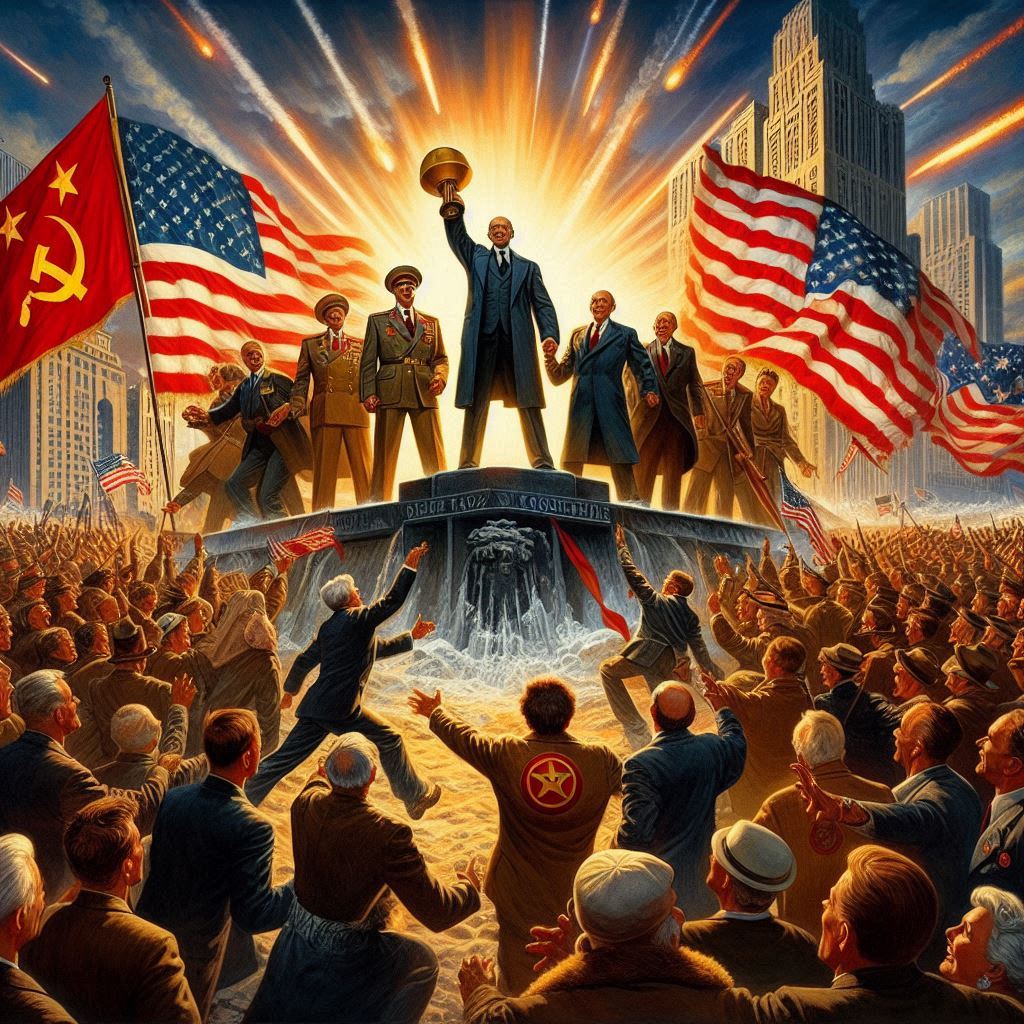從蘇聯垮台來看目前的美中關係。
蘇聯的垮台是多種內外因素共同作用的結果,主要包括:
經濟困境:蘇聯長期實行計劃經濟,但經濟效率低下,資源浪費嚴重。到了1980年代,經濟增長停滯,民生物資短缺,人民生活水平下降。
軍事負擔:冷戰期間,蘇聯投入大量資源進行軍備競賽,特別是在核武器和常規軍事力量上,這對蘇聯經濟造成巨大壓力。
政治體制僵化:蘇聯的共產黨專政體制缺乏有效的變革和創新,官僚主義嚴重,腐敗問題普遍,導致社會不滿和政治危機。
民族問題:蘇聯是由多個民族組成的聯邦,各民族之間的矛盾和自治要求不斷增加,特別是在波羅的海國家和中亞地區,民族獨立運動逐漸抬頭。
戈巴契夫(戈爾巴喬夫)的改革:1985年,戈巴契夫上台後,推行“改革和開放”(Perestroika 和 Glasnost)政策,試圖通過經濟改革和政治開放來挽救蘇聯,但結果適得其反,激化各種矛盾,最終導致蘇聯解體。
雷根的作用
美國前總統隆納·雷根(Ronald Reagan)在蘇聯垮台過程中發揮重要作用,主要表現在以下幾個方面:
軍備競賽:大幅增加美國軍費開支,推動“星球大戰”計劃(SDI),迫使蘇聯在軍備競賽中投入更多資源,加劇蘇聯的經濟困境。
強硬外交政策:公開譴責蘇聯的專制統治,稱蘇聯為“邪惡帝國”,並支持全球範圍內反共運動。
支持東歐變革:積極支持東歐國家的民主化運動,通過經濟援助和外交壓力,推動東歐國家擺脫蘇聯的控制,走向獨立和民主。
美國會這樣對付中國嗎?
美國對付中國的策略和對付蘇聯的方式有一些相似之處,但也有很大的不同:
經濟手段:與蘇聯不同,中國經濟實力強大,與全球經濟深度融合。美國主要通過貿易戰、科技禁運等經濟手段來打擊中國的經濟發展。
軍事競爭:美國在亞太地區加強軍事部署,通過與盟國的軍事合作和軍售,來遏制中國的軍事擴張。
意識形態對抗:美國通過宣傳人權和民主價值觀,來施壓中國的人權政策和政治體制,但不像冷戰期間對蘇聯那樣明確。
國際聯盟:美國積極與其他民主國家建立聯盟,共同應對中國的挑戰,如“四方安全對話”(Quad)和美歐合作。
總體來說,美國對付中國的策略更加複雜和多樣化,不僅僅局限於軍事和經濟方面,還涉及科技、外交、意識形態等多個領域。這樣的策略能否成功,還有待觀察,因為中國與蘇聯有著不同的國情和發展背景。
The Collapse of the Soviet Union
The collapse of the Soviet Union was the result of a combination of internal and external factors, including:
Economic Troubles: The Soviet Union operated a planned economy for a long time, but it was highly inefficient and wasteful. By the 1980s, economic growth had stalled, shortages of consumer goods were widespread, and the standard of living had declined.
Military Burden: During the Cold War, the Soviet Union allocated vast resources to the arms race, particularly in nuclear and conventional military forces, which placed tremendous pressure on its economy.
Political Stagnation: The Soviet Communist Party's authoritarian system lacked effective reform and innovation, leading to severe bureaucracy and widespread corruption, causing social discontent and political crisis.
Ethnic Issues: The Soviet Union was a federation of multiple ethnic groups, and tensions and demands for autonomy increased over time. Independence movements gradually emerged, particularly in the Baltic states and Central Asia.
Gorbachev's Reforms: After coming to power in 1985, Mikhail Gorbachev implemented policies of "Perestroika" (restructuring) and "Glasnost" (openness), aiming to save the Soviet Union through economic and political reforms. However, these reforms backfired, exacerbating various contradictions and ultimately leading to the Soviet Union's dissolution.
Reagan's Role
Former U.S. President Ronald Reagan played a significant role in the collapse of the Soviet Union through:
Arms Race: Significantly increasing U.S. military spending and promoting the Strategic Defense Initiative (SDI), also known as "Star Wars," forcing the Soviet Union to allocate more resources to the arms race, worsening its economic troubles.
Hardline Diplomacy: Publicly condemning the Soviet Union's authoritarian regime, labeling it an "Evil Empire," and supporting anti-communist movements worldwide.
Supporting Eastern European Change: Actively supporting the democratization movements in Eastern European countries through economic aid and diplomatic pressure, helping these countries break free from Soviet control and move towards independence and democracy.
Would the U.S. Use the Same Strategy Against China?
The U.S. strategy against China shares some similarities with its approach to the Soviet Union but also has significant differences:
Economic Measures: Unlike the Soviet Union, China has a strong economy deeply integrated into the global economy. The U.S. primarily uses economic measures like trade wars and technology embargoes to impact China's economic development.
Military Competition: The U.S. strengthens its military presence in the Asia-Pacific region and collaborates with allies through military cooperation and arms sales to contain China's military expansion.
Ideological Confrontation: The U.S. promotes human rights and democratic values to pressure China's human rights policies and political system, though not as explicitly as during the Cold War with the Soviet Union.
International Alliances: The U.S. actively builds alliances with other democratic nations to jointly address the challenges posed by China, such as through the Quad (Quadrilateral Security Dialogue) and U.S.-Europe cooperation.
Overall, the U.S. strategy against China is more complex and multifaceted, involving not just military and economic aspects but also technology, diplomacy, and ideology. Whether this strategy will succeed remains to be seen, given the different national conditions and developmental backgrounds of China and the Soviet Union.


照片:DALLE3
- 1
- 2
- 3
- 4
